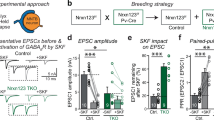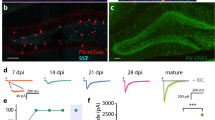Abstract
Neuregulins (also known as ARIA, NDF, heregulin, GGF) are a family of widely expressed growth and differentiation factors. Neuregulins secreted from motor neurons accumulate at maturing neuromuscular junctions, where they stimulate transcription of genes encoding specific acetylcholine receptors. How these factors function at central synapses, however, is unknown. In the maturing cerebellum, neuregulins are concentrated in glutamatergic mossy fibres that innervate granule cells in the internal granule-cell layer1. We have analysed the effects of neuregulins on the expression of genes encoding NMDA (N-methyl-D-aspartate) receptors in the cerebellum, because receptor composition changes dramatically as expression of the receptor NR2C subunit is specifically induced in neurons in the internal granule-cell layer during synaptogenesis. Here we report that addition of a neuregulin-β isoform to cultured cerebellar slices specifically increases the expression of NR2C messenger RNAs by at least 100-fold; effects are only minor with a neuregulin-α isoform. This stimulation of NR2C expression requires synaptic activity by NMDA receptors, as well as neuregulin-β. Addition of the NMDA-receptor-channel blocker AP-5 prevents upregulation of the NR2C subunit by neuregulin, whereas an AMPA/kainate-receptor antagonist does not. Consistent with these effects of neuregulin, we find that granule cells express its receptors ErbB2 and ErbB4 before the NR2C subunit of the NMDA receptor. Our results indicate that neuregulins regulate the composition of neurotransmitter receptors in maturing synapses in the brain, in a manner analogous to the neuromuscular junction.
This is a preview of subscription content, access via your institution
Access options
Subscribe to this journal
Receive 51 print issues and online access
$199.00 per year
only $3.90 per issue
Buy this article
- Purchase on Springer Link
- Instant access to full article PDF
Prices may be subject to local taxes which are calculated during checkout





Similar content being viewed by others
References
Sandrock, A. J., Goodearl, A. D., Yin, Q. W., Chang, D. & Fischbach, G. D. ARIA is concentrated in nerve terminals at neuromuscular junctions and at other synapses. J. Neurosci. 15, 6124–6136 (1995).
Watanabe, M., Inoue, Y., Sakimura, K. & Mishina, M. Developmental changes in distribution of NMDA receptor channel subunit mRNAs. NeuroReport 3, 1138–1140 (1992).
Farrant, M., Feldmeyer, D., Takahashi, T. & Cull-Candy, S. NMDA-receptor channel diversity in the developing cerebellum Nature 368, 335–339 (1994).
Feldmeyer, D. & Cull-Candy, S. Functional consequences of changes in NMDA receptor subunit expression during development. J. Neurocytol. 25, 857–867 (1996).
Stern, P., Behe, P., Schoepfer, R. & Colquhoun, D. Single-channel conductances of NMDA receptors expressed from cloned cDNAs: comparison with native receptors. Proc. R. Soc. Lond. B. 250, 271–277 (1992).
Takahashi, T. et al. Functional correlation of NMDA receptor epsilon subunits expression with the properties of single-channel and synaptic currents in the developing cerebellum. J. Neurosci. 16, 4376–4382 (1996).
Kadotani, H. et al. Motor discoordination results from combined gene disruption of the NMDA receptor NR2A and NR2C subunits, but not from single disruption of the NR2A or NR2C subunit. J. Neurosci. 16, 7859–7867 (1996).
Akazawa, C., Shigemoto, R., Bessho, Y., Nakanishi, S. & Mizuno, N. Differential expression of five N-methyl-D-aspartate receptor subunit mRNAs in the cerebellum of developing and adult rats. J. Comp. Neurol. 347, 150–160 (1994).
Buonanno, A. & Sasner, M. Gradients of NMDA receptor expression in developing cerebellar granule cells. Soc. Neurosci. Abstr. 21, 398.5 (1995).
Tanaka, M., Tomita, A., Yoshida, S., Yano, M. & Shimizu, H. Observation of the highly organized development of granule cells in rat cerebellar organotypic cultures. Brain Res. 641, 319–327 (1994).
Audinat, E., Lambolez, B., Rossier, J. & Crepel, F. Activity-dependent regulation of N-methyl-D-aspartate receptor subunit expression in rat cerebellar granule cells. Eur. J. Neurosci. 6, 1792–1800 (1994).
Fischbach, G. & Rosen, K. ARIA: A neuromuscular junction neuregulin. Annu. Rev. Neurosci. 20, 429–458 (1997).
Sandrock, A. J. et al. Maintenance of acetylcholine receptor number by neuregulins at the neuromuscular junction in vivo. Science 276, 599–603 (1997).
Meyer, D. & Birchmeier, C. Distinct isoforms of neuregulin are expressed in mesenchymal and neuronal cells during mouse development. Proc. Natl Acad. Sci. USA 91, 1064–1068 (1994).
Lu, H. S. et al. Studies on the structure and function of glycosylated and nonglycosylated neu differentiation factors. Similarities and differences of the alpha and beta isoforms. J. Biol. Chem. 270, 4784–4791 (1995).
Dong, Z. et al. Neu differentiation factor is a neuron-glia signal and regulates survival, proliferation, and maturation of rat Schwann cell precursors. Neuron 15, 585–596 (1995).
Jo, S. A., Zhu, X., Marchionni, M. A. & Burden, S. J. Neuregulins are concentrated at nerve-muscle synapses and activate ACh-receptor gene expression. Nature 373, 158–161 (1995).
Chu, G. C., Moscoso, L. M., Sliwkowski, M. X. & Merlie, J. P. Regulation of the acetylcholine receptor epsilon subunit gene by recombinant ARIA: an in vitro model for transynaptic gene regulation. Neuron 14, 329–339 (1995).
Altiok, N., Bessereau, J. L. & Changeux, J. P. ErbB3 and ErbB2/neu mediate the effect of heregulin on acetylcholine receptor gene expression in muscle: differential expression at the endplate. EMBO J. 14, 4258–4266 (1995).
Lu, H. S. et al. Post-translational processing of membrane-associated neu differentiation factor proisoforms expressed in mammalian cells. J. Biol. Chem. 270, 4775–4783 (1995).
Peles, E. & Yarden, Y. Neu and its ligands: From an oncogene to neural factors. BioEssays 15, 815–824 (1993).
Lemke, G. Neuregulins in development. Mol. Cell. Neurosci. 7, 247–262 (1996).
Carraway, K. L. & Cantley, L. C. Aneu acquaintance for erbB3 and erbB4: a role for receptor heterodimerization in growth signaling. Cell 78, 5–8 (1994).
Moscoso, L. M. et al. Synapse-associated expression of an acetylcholine receptor-inducing protein, ARIA/heregulin, and its putative receptors, ErbB2 and ErbB3, in developing mammalian muscle. Dev. Biol. 172, 158–169 (1995).
Levi, G., Gordon, R. D., Gallo, V., Wilkin, G. P. & Balazs, R. Putative acidic amino acid transmitters in the cerebellum. I. Depolarization-induced release. Brain Res. 239, 425–445 (1982).
Mishina, M. et al. Molecular distinction between fetal and adult forms of muscle acteylcholine receptor. Nature 321, 406–411 (1986).
Komuro, H. & Rakic, P. Modulation of neuronal migration by NMDA receptors. Science 260, 95–97 (1993).
Shahar, A., de Vellis, J., Vernadakis, A. & Haber, B. A Dissection and Tissue Culture Manual of the Nervous System(Liss, New York, (1989)).
Carroll, S. L., Miller, M. L., Frohnert, P. W., Kim, S. S. & Corbett, J. A. Expression of neuregulins and their putative receptors, ErbB2 and ErbB3, is induced during Wallerian degeneration. J. Neurosci. 17, 1642–1659 (1997).
Angerer, L. M. & Angerer, R. C. Detection of poly A+ RNA in sea urchin eggs and embryos by quantitative in situ hybridization. Nucleic Acids Res. 9, 2819–2840 (1981).
Acknowledgements
We thank Z. Yang, J. Cheng and Y. Miyazaki for technical assistance, S. Carroll for erbB cDNAs, Z. Hall and P. Nelson for critically reading the manuscript, and NICHD for support.
Author information
Authors and Affiliations
Corresponding author
Rights and permissions
About this article
Cite this article
Ozaki, M., Sasner, M., Yano, R. et al. Neuregulin-β induces expression of an NMDA-receptor subunit. Nature 390, 691–694 (1997). https://doi.org/10.1038/37795
Received:
Accepted:
Published:
Issue Date:
DOI: https://doi.org/10.1038/37795
This article is cited by
-
Plasma neuregulin 1 as a synaptic biomarker in Alzheimer’s disease: a discovery cohort study
Alzheimer's Research & Therapy (2022)
-
Global gene expression profiling of healthy human brain and its application in studying neurological disorders
Scientific Reports (2017)
-
Neuregulin 1 signalling modulates mGluR1 function in mesencephalic dopaminergic neurons
Molecular Psychiatry (2015)
-
Neuregulin1-β Decreases IL-1β-Induced Neutrophil Adhesion to Human Brain Microvascular Endothelial Cells
Translational Stroke Research (2015)
-
Neuregulin1/ErbB4-induced migration in ST14A striatal progenitors: calcium-dependent mechanisms and modulation by NMDA receptor activation
BMC Neuroscience (2011)
Comments
By submitting a comment you agree to abide by our Terms and Community Guidelines. If you find something abusive or that does not comply with our terms or guidelines please flag it as inappropriate.



